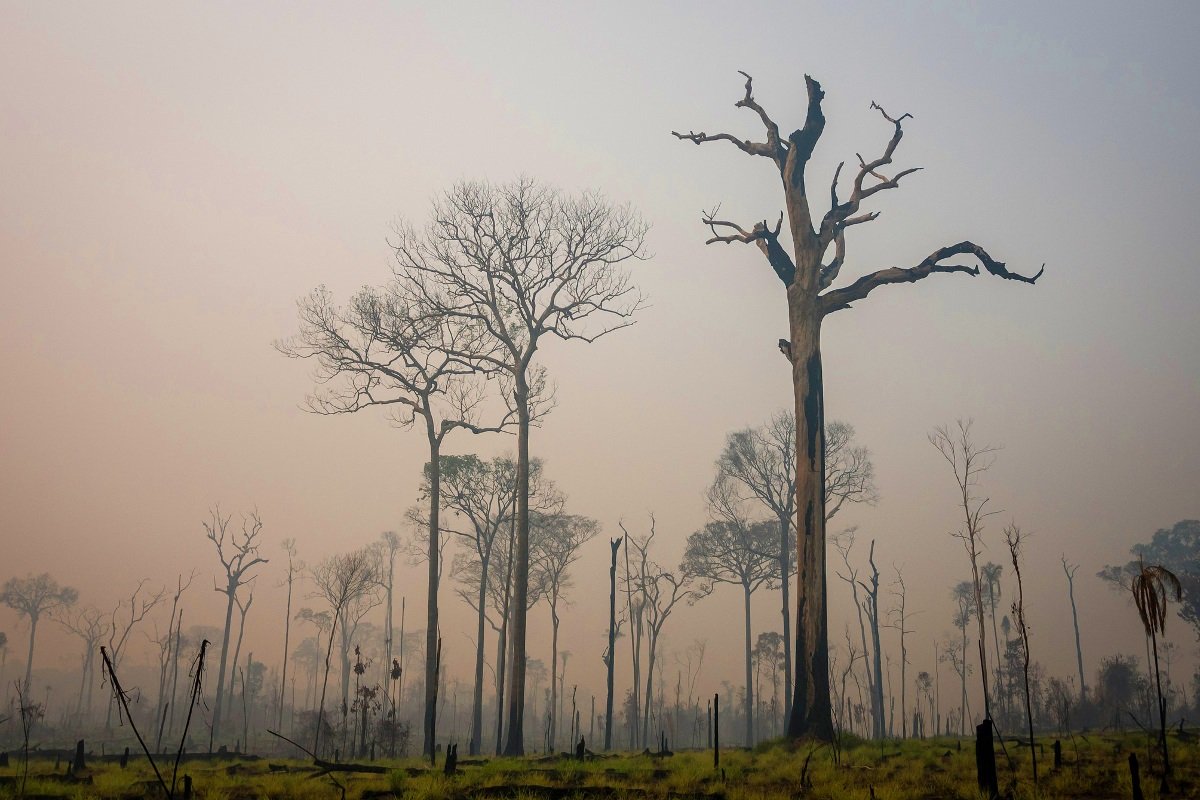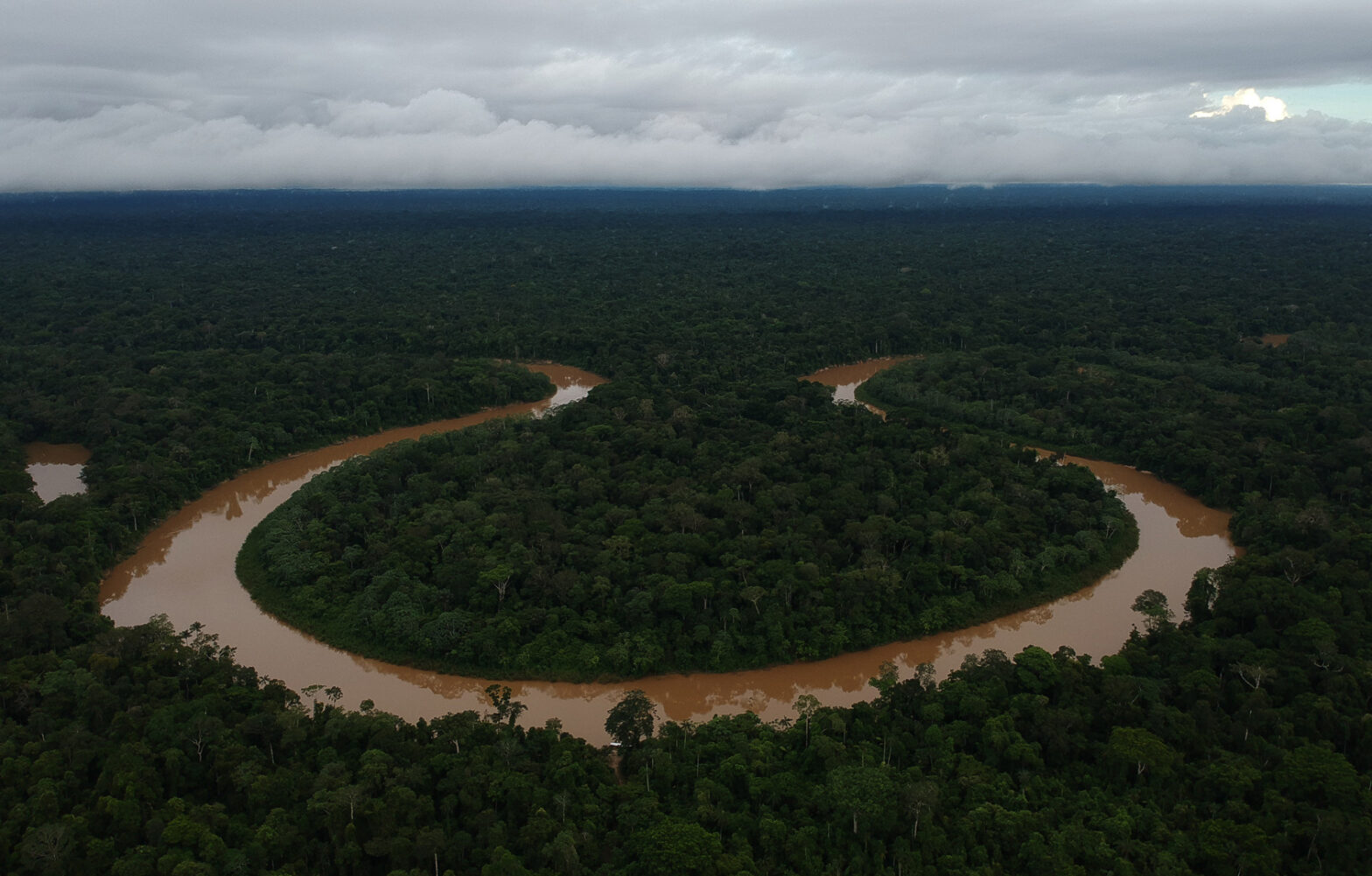The colonos and beiradeiros live sustainably, but a new ecological station created around them could force these rural people from their lands.
We left the indigenous village of Tukaya early in the morning, and later that day reached our final destination: the ESEC-TM (Terra do Meio Ecological Station), which we’d come to study. Our focus was the people who had settled there before the preserve was set up — people the government was asking to leave.
We arrived first at the house of José Alves Gomes de Silva (universally known as Zé Boi). He and his wife, Cleonice Neves da Silva, gave us a friendly welcome, cooking up large pans of fried fish, with manioc flour and rice. Zé Boi, credited in those parts with knowing the Iriiri River like the back of his hand, was to be our pilot and guide for most of the rest of our trip upriver and into the forest.
Born in the region, Zé Boi and his wife are both illiterate and have long struggled to make sure their children don’t face the same fate, despite the lack of schools along the river. That’s a major undertaking, considering that they’ve had 16 children, with only one having died in infancy.

Eleven years ago, they sent one of their older daughters, Francisca (Chica), to Altamira, a city of over 100,000, to look after her younger sisters while they attended school. But she always missed home. Her father wrote to her, dictating letters to a literate neighbour. When Chica came back, she married a local man who had waited for her, and they had three children.
“That’s enough!”, she said decisively. “We’re not having any more.”
Now that sterilization is readily available in Brazil, most of the younger women in this part of the Amazon have taken the same decision. Very few of Zé Boi’s children want their mother’s life of double-digit pregnancies.
Zé Boi’s family has a tame paca (Agouti paca), a large Amazonian rodent which they extracted from its dead mother’s womb and reared, using a baby’s bottle. Like most families, they love paca meat, but they are very fond of this young pet. When it reaches maturity, they say, it will disappear into the forest. While the paca sleeps during the day in a special box especially made for it, it wanders happily around the room in the evenings, often rubbing Zé Boi’s ankle.

Life in the Amazon wilds
Like most locals, Zé Boi’s family owns several emaciated dogs. One night while staying there, I woke to the commotion of their loud barking. The next morning I asked Zé Boi what the din had been about: “A band of boars passed by at the back of the house”, he replied.
How did he know? “The dogs have a different bark for different animals,” he replied, demonstrating the sort of intimate knowledge he and other families have of the forest and the creatures that live in it.
Daily life on the Iriri, in the heart of Amazonia, can be disrupted by things much worse than dogs. Zé Boi tells of the frightening encounters his family, and other families, have had with Kayapó Indians over the past century.
Zé Boi’s brothers and father were out collecting açaí (a tropical berry) once when Kayapó Indians arrived back at their hut. The warriors killed his grandmother and one of her sons, and took eight-year-old Isaura hostage. She was not recovered. Years later, Zé Boi’s father met Isaura again: fully integrated into indigenous society. She had married and had five Kayapó children. There was no talk of her returning to “white” society.

This isn’t the only trouble the family has experienced over the years. Like others, they endured violent threats from grileiros (land thieves) in the 1990s.
“It was turning this area into an ecological station that saved us”, explained Zé Boi. “We have conflicts now with ICMBio [the federal conservation authorities] and they are now telling us we must leave [because of the creation of the preserve], but they brought us a real blessing by getting rid of the grileiros.”
Brazil nutting
While staying with Zé Boi and his family, I and two biologists from our team joined him on a visit to his castanhal, the area where he collects Brazil nuts. A short boat ride and an hour-long walk through the forest, accompanied by the the sound of birds, insects and occasional monkeys, got us there. On the way, Zé Boi pointed out and named trees we passed, telling us their uses, often as a cure for common ailments.
I noticed that the bark of some trees had been scraped off. Zé Boi told us this was the work of tapirs. Biologist Ricardo Scoles, added to the natural history lesson, explaining that the animals “need salt and their stomachs are adapted to absorb bark,” much like North America’s porcupines.
When we reached the castanhal, we found that many ouriços (nutcases, the size of small beach balls, but far harder) had fallen to the ground. Zé Boi warned that there were many more still hanging on the tree far above us.
“I’ll keep an eye on the weather”, he said. “They fall most often when there is a heavy shower of rain and then the sun comes out.” Zé Boi is right to be cautious: many locals have been injured by a blow on the head from a plummeting ourico.

We were particularly careful near a large, spreading tree called a milouriços (1,000 ouriços). “Can it really carry that number of ouriços in a single harvest?” I asked. “Not every year,” Zé Boi responded. “And I think this year will be poor —but often it has more.” Quite incredible to see such a prolific tree.
Zé Boi pointed to a neat hole bored into some ouriços on the ground. “It was an agouti that did that”, he said. “No other animal has sharp enough teeth.”
When I asked if he was afraid the agoutis would damage the harvest, he shook his head. “We always wait until the river has risen a bit more, so we can take our boat down a creek and get nearer the castanhal”, he said. “The agoutis take what they need first and we take the rest. There is enough for us all.”

Ricardo explained that, when the agoutis have had their fill, they dig holes and bury the remaining nuts to eat later. But, just like squirrels, they often forget where they have buried them, thus helping to scatter the trees.
“Humans have played a role too”, he added. “We don’t yet know the extent of human involvement in the distribution of useful trees and other plants [in the Amazon], though we are certain that they played a role. There’s a lively debate on this issue between biologists, anthropologists and archaeologists.”
This long-occurring interaction between forest and people debunks the facetious claim made in the 1970s by the military government that the Amazon was “a land without men” needing to be colonized by wealthy Brazilian urbanites looking to make a quick profit on cattle, logging and mining.
Forced to leave the land they care for?
A few days later we visited the homes of some colonos (settlers). Peasants from various parts of Brazil, they began migrating to the Iriri River valley in the 1990s. In this particular case, the settlers had occupied plots of land beside a road going from the Iriri River to a cassiterite (tin) mine, operated by the Canopus mining company, a subsidiary of Rhodia, a multinational chemicals manufacturer.
When the Brazilian government officially established the 3.4 million hectare (13,000 square mile) ecological station, known as Estaçāo Ecológica da Terra do Meio (EsecTM) in the early 2000s, they launched a major crackdown on the illegal deforestation being perpetrated by large scale ranchers and farmers and land thieves within the preserve.
Representatives of about 60 colonos made contact with ICMBio, the environment agency, to plead their case. They told how they had occupied the land in good faith, long before the ecological station existed. They were willing to leave the conservation unit, they said, provided they were given equivalently productive land and resettled together (so that they could maintain the mutual help community networks they had set up). ICMBio has so far not offered alternative land, so they’ve stayed on, though are clearly troubled by the uncertainty.

The colonos we met all lived along the Iriri River and, rather unusually, were nearly all single men in their 60s and 70s. Although most had led restless lives, on the move constantly, leaving behind wives and children, they seemed happy enough. One of them, José Carlos Alves de Souza, 62 years old, showed us around his land, where he is cultivating food crops (maize, manioc, cacao and more). He has also planted fruit trees including Brazil nut seedlings, even though he knows that he won’t live long enough to collect the nuts.
This year he is going to visit a rare spot in the forest where uncut mahogany trees can still be found to collect seeds. He will plant them in his plot. “We can’t let these trees die out”, he said.
The lunch he offered us in his spotless kitchen was delicious — corn on the cob, rice cooked with pumpkin (lovely!), beans, and pork from a boar that he’d shot himself and cooked in a stew. He had never married, but has children in another Brazilian state, with whom he keeps in sporadic contact. Like the other colonos, his main worry today is that he might be evicted without compensation.

The colonos think of themselves as somewhat different from the beiradeiros [the river folk] in that they see themselves fundamentally as farmers: “My heart belongs to my crops” is how one of them put it.
They also don’t have the same fierce attachment to this particular river valley as do the beiradeiros. Yet, as they also recognise, their lives are in many ways very similar to those of the beiradeiros. The colonos live within the rhythms and patterns of nature in Amazonia, eating fish almost every day, for example. “The river is my fridge”, said one. And many collect Brazil nuts.
After we left the region, some colonos sent a letter to ICMBio. In it they asked for a similar study to be done on their lifestyle as the one we were doing on the beiradeiros’ way of life. The idea: to show that the colonos too are living sustainably, with little impact on the ecological integrity of the ESEC-TM that now surrounds them, that they should be allowed to stay on. In fact, these river people may be enhancing nature’s value for themselves, and possibly humanity.

Both colonos and beiradeiros know the value of terra preta, the incredibly fertile but mysterious black earth found in patches along the river, and many families have chosen to homestead and farm on that ground.
Indigenous communities produced this rich soil some time in the past, though no one knows quite when or how, and our study team frequently stumbled on hard archaeological evidence of that presence — pottery shards, axe heads and other flotsam.
Unlike the sandy soil beneath most of the forest, terra preta is extremely productive and, remarkably, stays that way. No matter what is grown in it, it retains its fertility — even though nothing is done to replenish it.
It is a phenomenon well worth studying. Unlocking its secrets could potentially benefit rainforest crops all across the Amazon and even throughout the tropics, where soil nutrient depletion remains a serious economic problem.
This is another valid reason to allow these river people to remain living within the ecological station. Like the indigenous people before them, the colonos and beiradeiros appear to be an integral part of their ecosystem — they are custodians of the land they love.



– This report was originally published in Mongabay and is republished by an agreement to share content.





